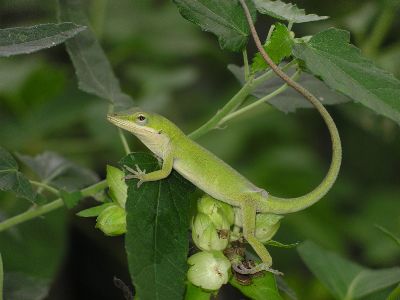Anole - Green
Scientific Name: Anolis carolinensis
Thu, 3rd April, 2025 - 10:43 pm GMT
Sponsor Ads:

Alternative Name
Scientific Name: Anolis carolinensisBasic Info
At maturity, Green Anoles will grow to a length of 5 to 8 inches. They are slenderly built, with a long, narrow head and a tail. Their tails are so long that they can be up to twice the length of their bodies. They are seen in several colors including, gray-brown, brown, and various shades of green, though most healthy males are bright green when non-threatened. Their colors depend largely on their environment and mood and will change depending on where they are kept and what conditions they are kept under. The male Anole also has a large pink fan of skin on its throat, called a dewlap. This is used for courtship rituals and when showing territoriality. It should be noted that some individuals may have white or blue dewlaps. They can climb and walk on almost all surfaces and they have fragile tails, which separates from the body if it is grabbed. This adaptation allows them to escape from predators.
Health
Anoles should be exposed to full spectrum UV lighting for about 13 hours a day. Many anoles do not drink water from a dish; instead they lick water droplets from leaves. It is important to recognize this when setting up a captive environment. Many will set up misting systems or sprays, which allow water to fall upon leaves mimicking dew drops or rain. Breeding Green Anoles breed from late March through early October. The female will lay a single white egg, which will then be covered. Green Anole eggs are typically seen under leaves, decaying wood, and in urban areas in trash. Their young will hatch sometime between two to five weeks later. In captivity breeding can be initiated if light periods are maintained for 14 plus hours a day and high temperatures, ranging between 88 and 90 degrees Fahrenheit, are set. Since the Green Anole likes to bury its eggs, in captivity a variety of substances can be used to imitate the natural environment. Some common ones are, sand, sawdust, peat, and moist soil.Habitat
Commonly seen in the Southeastern United States and in South AmericaBehavior
The Green Anole is an extremely popular pet. They are sometimes called "Chameleons" because they can change color a little, but they are not true chameleons. Green Anoles are quite shy, though some may become tolerant of handling with exposure to gentle caretakers, though they normally object to being handled unless they are handled frequently. They are active lizards and usually do well housed in groups of one male to one or more females. As is true with all reptiles in captivity it is best to try to mimic their natural environment. In the wild, they generally are arboreal and can often be found on basking on walls and fences. Green Anoles will require greenery, shade, and a moist environment. Use a large wire cage with live, edible plants for best results. Temperatures should be set at daytime temperatures of 30 degrees Celsius over the basking area to 25 degrees Celsius in the cooler shady areas. Nighttime temperatures should be decreased to a range of 18 degrees Celsius to twenty-three degrees Celsius. A high level of humidity should also be maintained. In the wild the Green Anole eats small insects and spiders. In captivity, feeding should consist of a balanced diet consisting largely of insects; some may also eat meat and small amounts of fruit. Some keepers also recommend sprinkling food with vitamin powder. For watering, spray the leaves of the plants and then they will drink in this manner. The average life span of the Green Anole ranges from 2 to 7 years.Origin
North AmericaHistory
The Green Anole is commonly seen in the Southeastern United States and in South America.Common Foods
N/ASponsor Ads:
If at first, the idea is not absurd, then there is no hope for it. -- Albert Einstein
Anole - Green
Coded by: BGID® | ALL RIGHTS RESERVED Copyright © 2000-2025
Disclaimer | Privacy | Report Errors / Contact | Credits








 President of the United States of America - Real Estate mogul, Pageant owner and now one of the most controversial men in political history.
President of the United States of America - Real Estate mogul, Pageant owner and now one of the most controversial men in political history.  Politician, US Vice President and President of the USA - Joseph Robinette Biden Jr.
Politician, US Vice President and President of the USA - Joseph Robinette Biden Jr.  versus
versus  Russia: 'The Evil Empire'? Are they all that bad or is it just the USA trying to portray Russia as bad because they are a world power with land bigger and a society very different from the USA ideal?
Russia: 'The Evil Empire'? Are they all that bad or is it just the USA trying to portray Russia as bad because they are a world power with land bigger and a society very different from the USA ideal?  Global warming has been in and out as the "latest" hot topic for many years. It is, according to modern scientists, the result of man-made industrial pollutants, clearing forested areas, agriculture, etc. But now they are thinking it started way before the Industrial Revolution...
Global warming has been in and out as the "latest" hot topic for many years. It is, according to modern scientists, the result of man-made industrial pollutants, clearing forested areas, agriculture, etc. But now they are thinking it started way before the Industrial Revolution... 
 Corona virus
Corona virus 
 Users with wide screen monitors can benefit from more content on every page.
Users with wide screen monitors can benefit from more content on every page.